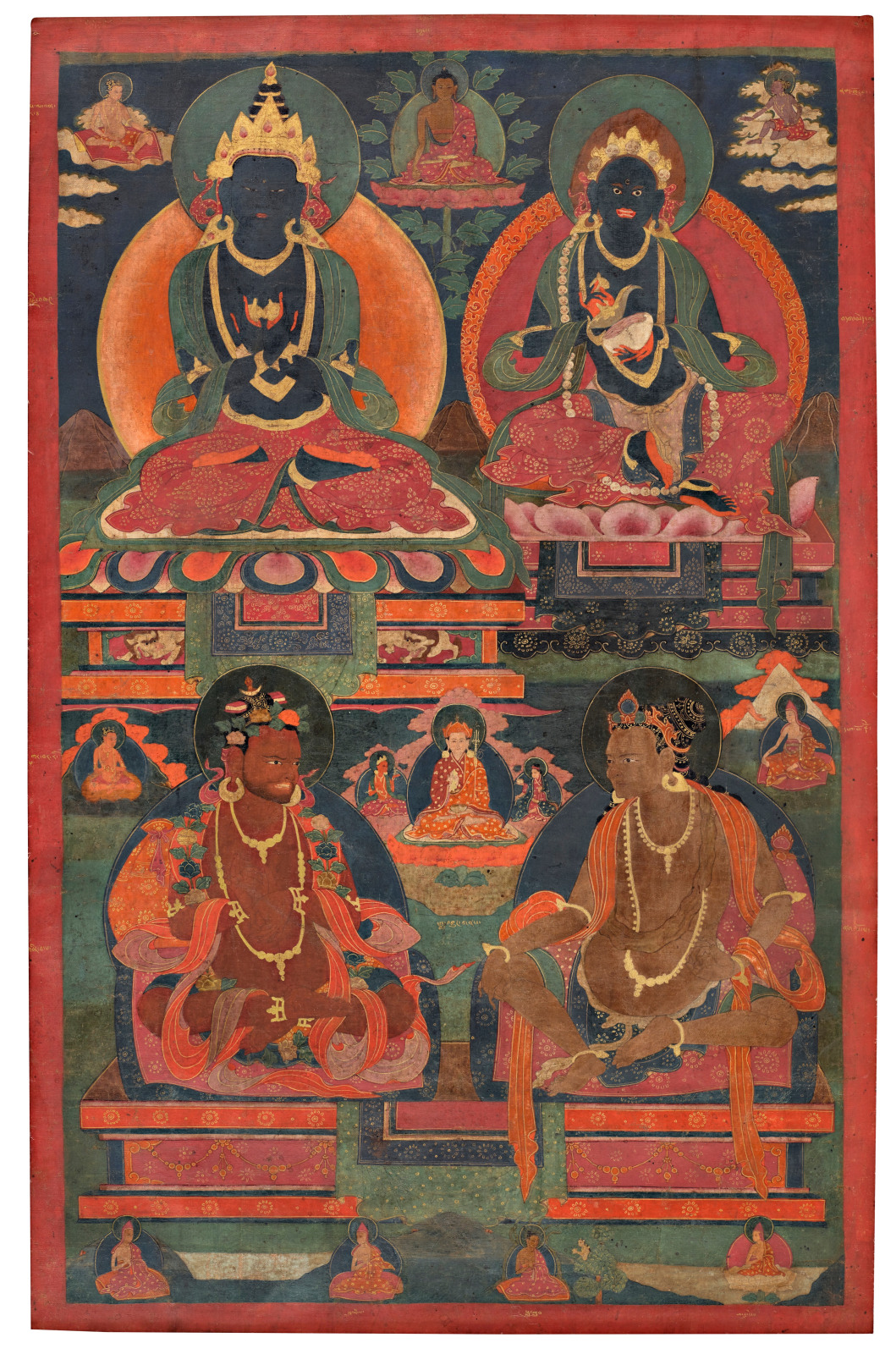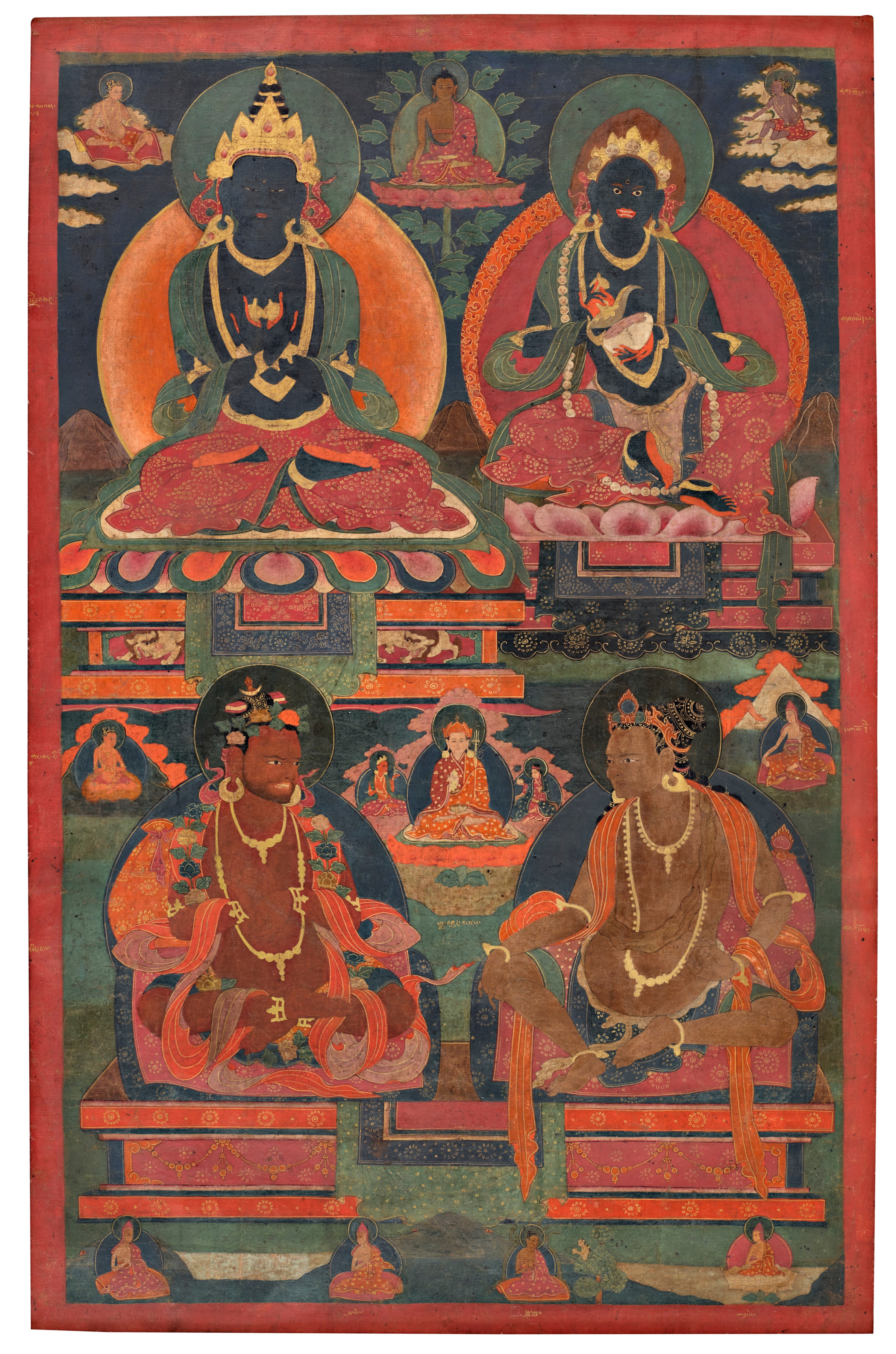
Provenance:
Giuseppe Tucci, Rome
Wildenstein Gallery, New York
Nasli and Alice Heeramaneck Collection, New York, 1955-1974
Christian Humann (Pan-Asian Collection), 1974-1982
Robert Hatfield Ellsworth, New York, 1982-1993
European Private Collection
Published:
Giuseppe Tucci, Tibetan Painted Scrolls, Rome, 1949, vol. II, p. 369, cat. no. 25, illus. pl. 46
This painting depicts the progenitors of the Lamdre esoteric teachings that are the core instructions of the Sakya order of Tibetan Buddhism. Inscriptions on the painting and in the margins identify the lineage. Vajradhara is seated on a lotus throne above left, with hands crossed in prajnalinganabhinaya mudra and holding a golden scepter (vajra) and bell (ghanta). The semi-wrathful goddess Nairatmya sits on a tiered dais to the right, holding the flaying knife (kartrika) and skull cup (kapala). In a distinctive use of perspective, Nairatmya’s throne is set further back in space than that of Vajradhara, while Indian mahasiddhas Virupa and Kanha share a pedestal below, sitting side by side as if in conversation. Shakyamuni Buddha appears in the uppermost register, with the mahasiddhas Abala Vajra and Garbharipa in clouds at either side. Padmasambhava and consorts Yeshe Tsogyal and Mandarava are seated on lotus flowers between Virupa and Kanha, with Nakkro and Pawo Dorje to the left and right seated in a mountainous landscape. The inscription beneath the pandita in the lower left is now illegible, but Luipa and Ludrup are identified in the center and Aryadeva to the right.
The four principal figures are the primogenitors of the Sakya Lamdre teachings, and the painting is thus likely to be the first in a large series depicting the gods, Indian mahasiddhas, and Tibetan Sakya masters of the lineage. Two more paintings from the series depict Tibetan Sakya hierarchs, each with a similar composition of four prominent figures set in simple landscape.[1] The composition of four figures seated in two registers is a common format in Sakya-lineage painting and seems to have been devised around the turn of the sixteenth century, as seen in a series of circa-1500 Sakya-lineage thangkas now dispersed in public and private collections, including one in the Los Angeles County Museum of Art.[2] The lamas depicted in the circa-1500 series are seated on elaborate snow-lion thrones with Nepalese-style toranas set against a midnight-blue background with a golden scrolling vine and flower design. The Tucci paintings represent a later development of this classic format, with the introduction of a simple landscape and less-elaborate thrones and date to around the end of the sixteenth or early seventeenth century.
Tucci noted that the dimensions of the painting were unusually long and narrow and that the cloth mounts were attached only to the top and bottom of the painting.[3] These mounts are now missing, but it may be assumed they were the type of simple dark-blue upper and lower fishtail-shaped textile mounts which predate the “rainbow” brocade frames that became popular in later periods.
1 Tucci, op. cit., pp. 369-370, cat. nos. 26-27, illus. pls. 47-48
2 See Pratapaditya Pal, Art of Tibet, Los Angeles, 1983, p. 150, cat. no. P15, pl. 20 and cover
3 Tucci, op. cit., p. 370

